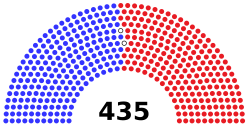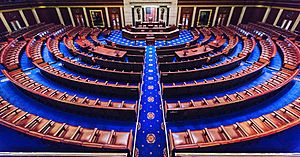United States House of Representatives facts for kids
Quick facts for kids United States House of Representatives |
|
|---|---|
| 118th United States Congress | |

Seal of the House
|
|

Flag of the United States House of Representatives
|
|
| Type | |
| Type | |
|
Term limits
|
None |
| History | |
|
New session started
|
January 3, 2023 |
| Leadership | |
| Structure | |
| Seats | 435 voting members 6 non-voting members 218 for a majority |
 |
|
|
Political groups
|
Majority (221)
Minority (212)
Vacant (2)
|
|
Length of term
|
2 years |
| Elections | |
| Plurality voting in 46 states Varies in 4 states
|
|
|
Last election
|
November 8, 2022 |
|
Next election
|
November 5, 2024 |
| Redistricting | State legislatures or redistricting commissions, varies by state |
| Meeting place | |
 |
|
| House of Representatives Chamber United States Capitol Washington, D.C. United States of America |
|
The United States House of Representatives is an important part of the United States (U.S.) Congress. Congress is the group that makes federal laws for the U.S. government. The other part of Congress is the U.S. Senate.
The House of Representatives has up to 435 members. These members are called U.S. Representatives or simply representatives. The number of representatives each state has depends on its population, which is counted every ten years by the United States Census Bureau. Every state gets at least one representative, no matter how small its population.
The House of Representatives meets in one wing of the U.S. Capitol building in Washington, D.C. The other wing is for the Senate. People sometimes call the House of Representatives "the House." The leader of the U.S. House of Representatives is called the Speaker of the House.
The U.S. Constitution says that all bills (ideas for new laws) about raising money, like taxes, must start in the House of Representatives. The House also has the special power to impeach (accuse of wrongdoing) certain officials, like the president or federal judges. The House can also remove one of its own members if at least two-thirds of the members vote for it.
Contents
Understanding the House of Representatives
How Members Are Chosen
The number of representatives for each state is based on its population. This is found by a census (a count of all people) done every ten years. Each state is guaranteed to have at least one representative.
The Constitution says there should not be more than one representative for every 30,000 people. However, the number of voting members in the House has been set at 435 since 1911. When Alaska and Hawaii joined the U.S. in 1959, the number briefly went up to 437, but it returned to 435 after the 1960 census.
Some areas, like the District of Columbia and U.S. territories (such as Puerto Rico, American Samoa, Guam, the Northern Mariana Islands, and the U.S. Virgin Islands), have non-voting delegates. These delegates can speak in debates and work in committees, but they cannot vote on final laws.
Drawing District Lines
States with more than one representative are divided into areas called districts. Each district elects one representative. States usually redraw these district lines after each census. This is done by state lawmakers or special groups.
District populations must be roughly equal in size. Also, new district lines cannot be drawn to unfairly hurt or help certain racial or language minority voters. Sometimes, district lines are drawn in a way that helps one political party more than another. This is called gerrymandering.
Who Can Be a Representative?
To be a representative, a person must:
- Be at least 25 years old.
- Have been a U.S. citizen for at least seven years.
- Live in the state they represent when they are elected.
While they usually live in the specific district they represent, it's not a strict rule.
A person cannot be a representative if they took an oath to support the Constitution but then rebelled against the U.S. or helped its enemies. This rule was made after the Civil War. However, Congress can allow such a person to serve if two-thirds of both the House and Senate agree.
How Elections Work
Elections for representatives happen every two years. They are held on Election Day, which is the first Tuesday after the first Monday in November, in even-numbered years. Representatives serve a two-year term, and there is no limit to how many terms they can serve.
Most states use a "first-past-the-post" system. This means the candidate with the most votes wins. Some states use different systems, like ranked-choice voting or a two-round system where a runoff election is held if no one gets a majority.
If a representative leaves office before their term ends (for example, if they resign or pass away), a special election is held to choose a new member. The new member serves for the rest of the original term.
Non-Voting Members
Historically, many U.S. territories have sent non-voting delegates to the House. Today, the District of Columbia and five inhabited U.S. territories each elect a delegate. These delegates can speak in debates and introduce bills, but they cannot vote on the final passage of laws.
Terms and Rules
Representatives serve for two-year terms. A term begins on January 3 after the election in November.
The House can remove a member with a two-thirds vote. This is called expulsion. Only a few members have been expelled in U.S. history. For example, some were removed in 1861 for supporting the Confederacy. More recently, some were expelled for serious crimes like bribery or fraud.
The House can also formally censure or reprimand a member. This is a less severe punishment and only needs a simple majority vote. It does not remove the member from office.
House vs. Senate: What's Different?
The House and the Senate have different powers. The Senate has powers like approving treaties and confirming people chosen for the President's Cabinet.
However, the House has special powers too:
- It must start all bills about raising money (like taxes).
- It can impeach (accuse) officials.
- It chooses the president if no candidate wins enough votes in the Electoral College.
The Senate has longer terms (six years) and fewer members (100, two from each state). The House has shorter terms (two years) and more members (435). The Senate is often called the "upper" house, and the House of Representatives is called the "lower" house.
How the House Works
Daily Meetings
The House of Representatives meets in the United States Capitol building in Washington, D.C. The Speaker, who is the leader, sits at a special stand called a rostrum. Members' seats are arranged in a half-circle. Democrats usually sit on the left side, and Republicans on the right.
Meetings are usually held on weekdays and are open to the public. You can watch them live on TV or online. The House follows a set of rules, customs, and traditions. The Speaker makes sure these rules are followed and uses a gavel to keep order.
When a new bill (idea for a law) is introduced, it is placed in a special box called the "hopper."
The House has an official called the Sergeant at Arms. This person carries a special staff called the Mace to open all House sessions. It is a tradition from 1789.
For the House to do business, a majority of its members must be present. This is called a quorum. Usually, it's assumed a quorum is present unless someone officially points out that it's not.
During debates, members can only speak if the Speaker calls on them. They must address the Speaker, not other members directly. Members usually refer to each other by their state, like "the gentleman from Virginia."
Passing Laws
The House has its own rules for passing laws. These rules can change with each new Congress. Before a bill is voted on, a special group called the Rules Committee sets rules for how long the debate will be and if changes (amendments) can be made to the bill.
Debate on a bill is usually limited to one hour, split equally between the two main political parties. A "floor manager" from each party helps manage the time. Because many members want to speak, they might only get a minute or even 30 seconds to share their thoughts.
After the debate, members vote. Often, they vote by voice, saying "yea" (yes) or "nay" (no). If a member wants a more formal vote, they can ask for a "recorded vote." This means each member's vote is officially counted.
Recorded votes can be done in a few ways:
- Electronically: Members use a special card at voting stations. This is the most common way.
- By teller: Members hand in colored cards (green for yes, red for no, orange for present). This is used if electronic voting has problems.
- Roll call: The Clerk reads each member's name, and they say their vote. This is rare because it takes a long time.
Voting usually lasts about 15 minutes. The Speaker can vote like other members. If there is a tie vote, the motion (the idea being voted on) does not pass.
Titles for Representatives
Members of the House are often called "representative," "congressman," or "congresswoman." Before their names, they use the title "The Honorable."
Images for kids
-
Former House Speaker Nancy Pelosi, Former Majority Leader Steny Hoyer, and Former Education and Labor Committee Chairman George Miller confer with President Barack Obama at the Oval Office in 2009.
See also
 In Spanish: Cámara de Representantes de los Estados Unidos para niños
In Spanish: Cámara de Representantes de los Estados Unidos para niños





